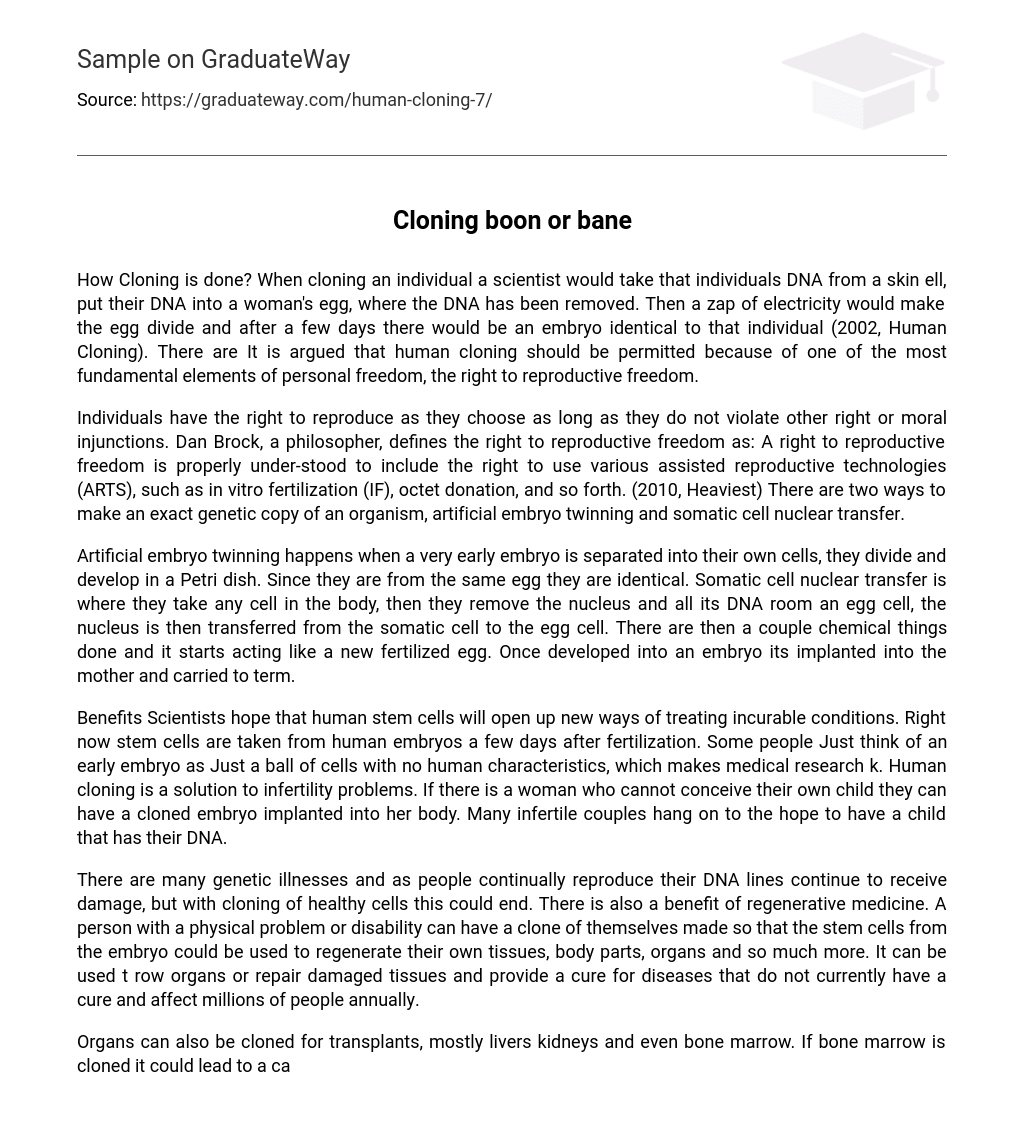How Cloning is done? When cloning an individual a scientist would take that individuals DNA from a skin ell, put their DNA into a woman’s egg, where the DNA has been removed. Then a zap of electricity would make the egg divide and after a few days there would be an embryo identical to that individual (2002, Human Cloning). There are It is argued that human cloning should be permitted because of one of the most fundamental elements of personal freedom, the right to reproductive freedom.
Individuals have the right to reproduce as they choose as long as they do not violate other right or moral injunctions. Dan Brock, a philosopher, defines the right to reproductive freedom as: A right to reproductive freedom is properly under-stood to include the right to use various assisted reproductive technologies (ARTS), such as in vitro fertilization (IF), octet donation, and so forth. (2010, Heaviest) There are two ways to make an exact genetic copy of an organism, artificial embryo twinning and somatic cell nuclear transfer.
Artificial embryo twinning happens when a very early embryo is separated into their own cells, they divide and develop in a Petri dish. Since they are from the same egg they are identical. Somatic cell nuclear transfer is where they take any cell in the body, then they remove the nucleus and all its DNA room an egg cell, the nucleus is then transferred from the somatic cell to the egg cell. There are then a couple chemical things done and it starts acting like a new fertilized egg. Once developed into an embryo its implanted into the mother and carried to term.
Benefits Scientists hope that human stem cells will open up new ways of treating incurable conditions. Right now stem cells are taken from human embryos a few days after fertilization. Some people Just think of an early embryo as Just a ball of cells with no human characteristics, which makes medical research k. Human cloning is a solution to infertility problems. If there is a woman who cannot conceive their own child they can have a cloned embryo implanted into her body. Many infertile couples hang on to the hope to have a child that has their DNA.
There are many genetic illnesses and as people continually reproduce their DNA lines continue to receive damage, but with cloning of healthy cells this could end. There is also a benefit of regenerative medicine. A person with a physical problem or disability can have a clone of themselves made so that the stem cells from the embryo could be used to regenerate their own tissues, body parts, organs and so much more. It can be used t row organs or repair damaged tissues and provide a cure for diseases that do not currently have a cure and affect millions of people annually.
Organs can also be cloned for transplants, mostly livers kidneys and even bone marrow. If bone marrow is cloned it could lead to a cause for cancer. Right now cloning organs for transplant is potentially the biggest benefit in the medical field. If a person were to get into an accident and need a transplant there would be one for them because of cloning of their owns cells. Also their recovery time would be faster. Risks Although there are many benefits to cloning, there are also many risks. When it comes to human cloning there is a loss of gene diversity.
When there is a loss of gene diversity, natural gene mutations that help species survive new viruses are lost, a new virus could wipe out an entire group of clones. In 1996, Dolly the sheep was the first animal that was cloned from DNA from an adult sheep. There were questions of whether she would live to a normal age or if her age would progress faster than a normal sheep, she died in February of 2003 from lung cancer. Dolly was the only sheep out of 277 attempts that was a live birth. According to John Killer the president of the Centre for Bioethics and Human
Dignity in the United States, “The majority of published research shows that death o mutilation of the clone are the most likely outcomes of mammalian cloning” “To subject human beings to cloning is not taking an unknown risk, it’s knowingly harming people” (Human Cloning, 2002) There have been poor success rates when it comes to animal cloning so it is very possible that there will be poor success rates when it comes to humans. There is alls a high risk for miscarriage and deformities. Animals that have been cloned have poop immune systems and they have a higher chance for infections.
Not only does it fail cost of the time, but it is very expensive. Creating a cloned embryo requires human egg cells, scientists will use fewer egg if cloning is used on people. Even if it required 100 eggs, taken from 10 donors, the cost of Just paying the donors could easily reach $50,000, then there is medical costs on top of that. The costs to treat one person could be above $100,000. (Harper,2001) It also goes against God. God made every person the way they are for a reason, n for someone to change them. With all of the risks involved in the cloning process, it should never be legal and it is not ethical.





